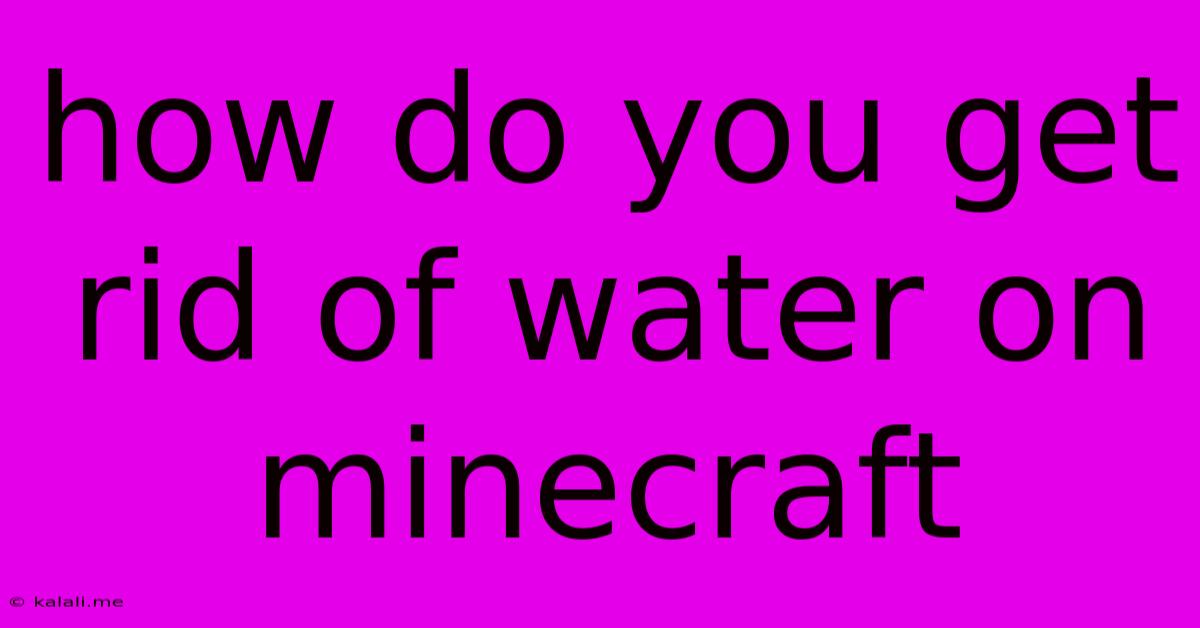How Do You Get Rid Of Water On Minecraft
Kalali
Jun 09, 2025 · 3 min read

Table of Contents
How to Get Rid of Unwanted Water in Minecraft: A Comprehensive Guide
Dealing with unwanted water in Minecraft can be a real nuisance, whether it's a pesky puddle hindering your building projects or a sprawling ocean threatening to flood your base. This guide provides various methods to effectively remove water, catering to different situations and skill levels. From simple buckets to advanced redstone contraptions, we'll cover all the bases to help you reclaim your dry land.
Understanding Water Mechanics in Minecraft
Before diving into solutions, it's crucial to understand how water behaves in Minecraft. Water flows downhill, spreading until it reaches a stable level or a barrier. This behavior dictates how we can effectively remove it. Understanding source blocks (the original block of water) is also key; removing these stops further water generation.
Simple and Effective Methods:
-
Buckets: The most basic, yet highly effective method. Simply use an empty bucket to collect water, one bucketful at a time. While time-consuming for large areas, it's reliable and requires no special tools or knowledge. This is perfect for small puddles or accidental spills.
-
Sponges: Sponges are a game-changer for water removal. A wet sponge absorbs water instantly, making them perfect for quick cleanup. You can then squeeze the sponge to retrieve the water and reuse it – or simply throw away the saturated sponge. Sponges are particularly useful for clearing large quantities of water efficiently. Remember to obtain sponges by finding ocean monuments or trading with villagers.
-
Draining with Blocks: This is a simple but effective technique for channeling water away from your desired location. Carefully place blocks to create a pathway for the water to flow downhill, directing it to a safe location such as a designated area or a body of water you already want to fill.
More Advanced Techniques:
-
Using Gravity and Channels: For larger water bodies, strategically placing blocks to create channels can effectively drain the water. The key is to create a gentle slope that guides the water downwards to a desired point – maybe even down into a pre-dug hole or ravine. Think carefully about the terrain to create an efficient water drainage system.
-
Redstone Contraptions: For the technically inclined, redstone contraptions offer advanced solutions for water removal, especially in automated systems or large-scale projects. These often involve pistons and water currents to move and control water flow precisely. Although highly effective, this approach requires significantly more effort and knowledge of redstone mechanics. This is typically beyond the scope of a beginner player.
-
Sand and Gravel: These blocks replace water blocks upon placement, making them excellent tools for clearing out unwanted water, especially in a specific area or to stop further spread. Be mindful of the blocks falling and potentially causing further issues.
Preventing Future Water Problems:
-
Careful Building: Avoid building near water sources without a proper plan to prevent accidental flooding.
-
Protective Walls/Barriers: Construct barriers, such as walls or fences, to prevent the spread of unwanted water.
-
Drainage Systems: Plan ahead and create preemptive drainage systems to handle any unexpected water accumulation.
By mastering these techniques, you'll be well-equipped to handle any water-related challenges in your Minecraft world, ensuring your builds remain dry and your gameplay smooth. Remember to always save your game frequently, especially when working on large-scale water management projects. Happy building!
Latest Posts
Latest Posts
-
How To Remove Stains With Bleach
Jun 10, 2025
-
How To Anchor A Bookcase To A Wall
Jun 10, 2025
-
For A Few Dollars More Ending Explained
Jun 10, 2025
-
Best Way To Clean Jets In Whirlpool Tub
Jun 10, 2025
-
Do College Calculus Let You Use Calculator
Jun 10, 2025
Related Post
Thank you for visiting our website which covers about How Do You Get Rid Of Water On Minecraft . We hope the information provided has been useful to you. Feel free to contact us if you have any questions or need further assistance. See you next time and don't miss to bookmark.